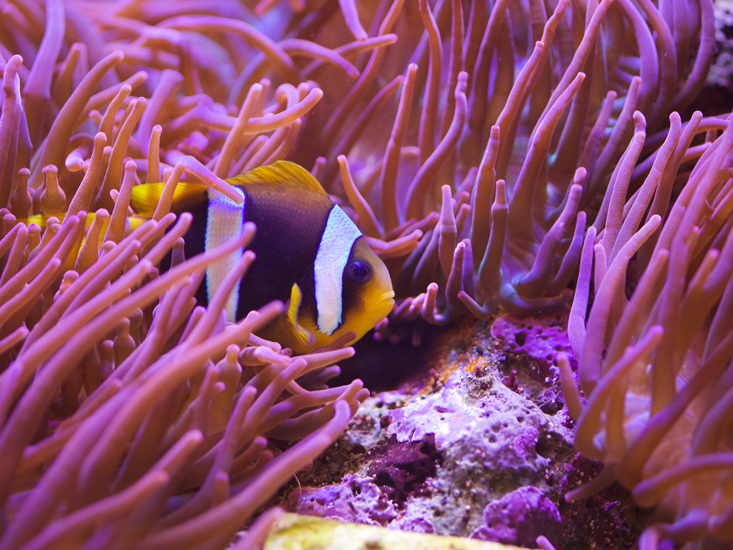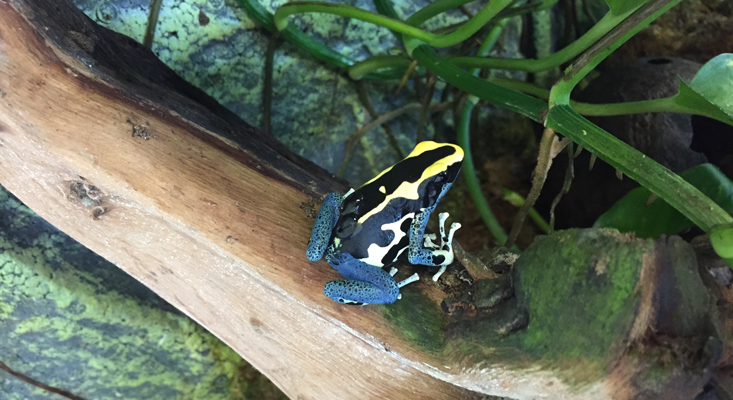
Becoming a parent brings out the best in many animals. Although parenting is usually left to the females, males from many species go above and beyond to care for the offspring. Take anemonefish. In Finding Nemo, Marlin swims over 1,000 miles from the Great Barrier Reef to Sydney to rescue his son Nemo, who had been captured by scuba divers. In reality, anemonefish rarely stray so far away from their home. But, like Marlin, they are excellent fathers.
Anemonefish, commonly called clownfish, live in sea anemones, and reside in the same location for most of their lives. Although sea anemones are one of the most venomous creatures in the sea, clownfish are immune because they have a mucus layer on their skin that protects them. This setup helps both animals. Clownfish usually lay their eggs on a patch of bare rock that is protected by the poisonous tentacles of sea anemones. In exchange, the territorial fish defend the sea anemones from predators.
“The males are spectacular fathers,” said Justin Rhodes, a psychology professor at the University of Illinois, Urbana-Champaign. “When we study them in the lab, we can see how they nurture the eggs and then switch their behavior and become aggressive toward intruders.”
Despite their smaller size, the males help the females defend the nest, but only the male anemonefish take care of it. They use their fins as fans to provide a constant flow of oxygen and keep the surroundings clean by nipping out the debris.

Male three-spined sticklebacks, which are tinier, leaner, and less colorful than the clownfish, are even better dads. They put a lot of effort in building the nests. “They make nests made of algae and other material, and then glue it all together,” said Alison Bell, a professor of ecology, evolution, and conservation at the University of Illinois, Urbana-Champaign.
The eggs take about five days to hatch. During this critical period, dads fan them vigorously to provide oxygen and remove the debris. They also pick up the eggs in their mouths and move them around to remove any bacteria or fungus. Researchers who study them in the lab often see the males dart out and attack any predator that makes the mistake of coming too close to the nest. Even in the wild, these dads protect the nest from predators. According to Bell, one of the biggest threats come from female sticklebacks, who form gangs and attack the nests to eat all the eggs.
Males defend the newborn fish and bring back the ones who stray too far from the nest. “Once the fish grow up, they become a little bit more independent and start to swim away,” Bell said. “The dads chase them, pick them up in his mouth, and spit them back into his nest. Eventually, he gets to the point where he can’t keep track of them and that’s when they disperse.”

Doting fathers are not restricted to the world of fish. Although many frogs desert their spawn, poison frog fathers are very protective of their young. Like the fish dads, the male dyeing poison dart frogs also defend and clean their nests, which are made on land. They then transport the tadpoles to water pools by giving them a piggyback ride. The dad sits in the remains of the gelatinous egg clutch and the tadpoles wriggle up his hind limbs and onto his back. In some poison frog species, the dads also alert the moms when the young ones are hungry and need to be fed.
“Most of us are used to thinking that moms are the nurturing caregivers,” said Eva Fischer, an assistant professor of ecology, evolution, and conservation biology at the University of Illinois, Urbana-Champaign. “In fish and frogs, it’s actually more common for the dads to provide care.”
The number of tadpoles that get a piggyback ride also changes depending on the species. According to Lauren O’Connell, a professor of biology at Stanford University, dads decide how many tadpoles to carry based on how aggressive the tadpoles are. “If they are aggressive, the dad carries them one at a time to different pools of water. If they are not, then the dad will carry them all on his back like a school bus,” O’Connell said.
The males are spectacular fathers. They nurture the eggs and become aggressive toward intruders.
Along with the caring males in the water world, several terrestrial dads help the young. Emperor penguins are easily recognizable for their black and while tuxedo ensemble. What’s fascinating about the males is they spend months without eating while balancing the egg on their feet in subzero weather. Males huddle together to share the warmth until their chicks hatch. Dads also provide the chicks with their first meal till the moms return to feed them with fish.
Resembling plush pillows that have been mounted on chopsticks, Rhea, flightless birds related to the ostrich, are also exceptional fathers, incubating their eggs for two months, while living on just two weeks of food. Unlike the emperor penguins who only have to worry about one baby, these dads can keep up to 60 eggs warm. In fact, they serve as the only parent, taking care of the chicks and protecting them for almost two years.
Ananya Sen is a graduate student in microbiology at the University of Illinois at Urbana-Champaign. She is also a science writer and her articles can be found here.


























